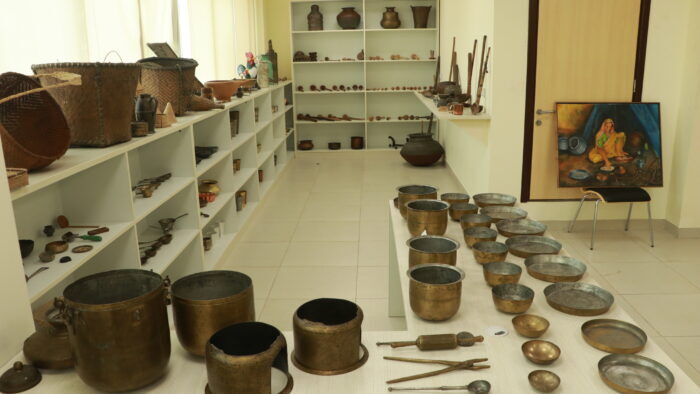Nothing can Weigh Up to the Unique Experience, Wide Range of Indigenous Ingredients of Indian Cuisine: Chef Thirugnanasambantham, Principal, Welcomgroup Graduate School of Hotel Administration (WGSHA)
Indian food has always felt like home even to non-Indians. A simple dish can feel like royalty. Tourists flock to India not just for its magnificent sights but also to savour our food. The World Travel and Tourism Council (WTTC) stated that India has the potential to become the world’s number one tourist destination more so from the hotel business. The Indian tourism and hospitality industry is a key promoter for the growth of the service sector in India.
In conversation with CSP, Chef Thirugnanasambantham, Principal, Welcomgroup Graduate School of Hotel Administration (WGSHA) spoke to us about his journey in the industry, the significance of Indian cooking and his vision of a leading hospitality sector.

How did your interest develop in cooking? Can you tell us a memorable stint of yours that has had a deep impact in your career?
I never had an intention of doing Hotel Management, and initially wanted to pursue biochemistry but missed the cut off by 2 points. So, I went for BSc. in Nutrition, food service management and dietetics, as nutrition was the upcoming course at that time. During my degree, we had to undergo two internships. The first one was a clinical internship in a hospital where we had to meet patients and prescribe suitable diets for diseases. The second internship was in a hotel, and I found it extremely interesting. It was very lively and engaging, and that is when my inclination shifted towards the hospitality industry. After the completion of my degree, I did not continue my master’s in clinical nutrition and instead, went to IHM Chennai for MSc. in Hotel Management. I started my career as an HOT with the Taj Group of Hotels and was in the pre-opening team for their upcoming restaurant, The Patio. It was the finest restaurant in South India where lunch and dinner were served in two different concepts. For lunch, we served contemporary French cuisine and the dinner was classical European cuisine. We had a lot of imported items on the menu including foie gras, T-bone steak, ribeye steak, porterhouse steak, caviar, and truffles, which none of the other hotels were serving at the time. There were no cooks in that restaurant, only chef de parties, senior chef de parties and sous chefs. I got the opportunity to train under renowned chefs like Chef Anton Mosimann and Chef Jean Michel and got to work with exotic ingredients. Working in that restaurant was a great opportunity for me and it created a passion to continue in this profession.

Indian cooking has travelled the globe and we now see multiple restaurants around the world. Is there anything in particular the world is missing out on in terms of Indian cuisine?
I have travelled across 10 countries and have realized that the concept of Indian food around the world is extremely standardized with a few signature dishes like butter chicken or dal makhni that people generally relate with our cuisine. We are gradually shifting from the traditional platter-to-plate style, towards plated service. A few Chefs including Chef Hari Nayak at Jhol and Chef Manish Mehrotra at Indian Accent are serving contemporary Indian cuisine in their restaurants with unique plating and presentation styles. They have increased the popularity of Indian food on the global map, but there are still a few things including the availability of indigenous ingredients from different geographical locations throughout the country, that cannot be achieved. India is a vast country with a large assortment of ingredients from different regions and sub-regions, and even though a lot of food items are now being exported to other countries, there are still many challenges that are being faced. Nothing can weigh up to the unique experience and wide range of indigenous ingredients that Indian cuisine has to offer.
How is the to-be introduced course in Indian cooking at WGSHA going to benefit students? Why is it necessary in your view to have this course? Do you think Indians require it too?
The global demand for Indian Chefs is increasing as the cuisine is gaining popularity. Many young chefs are bringing in innovative ideas, which coupled with their creativity is helping in transforming Indian cuisine. There is a huge potential for Indian food which requires trained professionals who have exclusive knowledge and skill set to meet the current demand. The unique feature of this course is the introduction of block syllabus which is not practiced in a lot of culinary and hospitality management colleges. Students will have a maximum of 4-5 blocks each term that will be delivered on a daily basis. The purpose is to give a constant input and complete each block within 20-25 days, wherein students will completely understand each and every product and learn to make commercialized products from scratch. There are a lot of other things they will learn besides cooking. They will acquire knowledge about various ingredients as well as the different cooking techniques that have been developed by our ancestors. We will also be concentrating on contemporary Indian cooking so that our students learn to innovate and give a twist to Indian food along with presentation skills. It will really benefit the students and they will be qualified to take up professions in various streams like entrepreneurship, hotels, restaurants, etc.

The culinary museum was a huge success and entered the Limca book of records. Can you tell us what the inspiration behind setting up this museum was? What does the museum hold and what has the attention been like?
I would like to thank our distinguished alumni, chef and author, Vikas Khanna for endorsing this museum. It was a great initiative to contribute to his alma mater and preserve our heritage and culture. Entering the Limca book of records was a surprise for Chef Vikas from the WGSHA family. We plan to collect more traditional equipment from different parts of the country and hopefully have a Guinness world record in the future. It is a continuous process and we are gradually adding more utensils along with collecting stories behind the traditional use of these equipment. We are still at a nascent stage and there is still a long way to go but we hope for the best.
 How can we create more awareness to traditional Indian cookware that is also instrumental to the unique taste of Indian cuisine apart from the spices?
How can we create more awareness to traditional Indian cookware that is also instrumental to the unique taste of Indian cuisine apart from the spices?
Due to globalization, men and women have started working more and have less time for cooking. Due to this, people have started purchasing modern cookware made of stainless steel and teflon that cut down the cooking time. Our ancestors used utensils that were scientifically tested to be suitable for different food items. Of late, people are not paying attention to these traditional equipment in the hope of cooking with less oil and fat. Teflon is said to contain a carcinogenic chemical which has adverse effects on the health, and people are gradually becoming aware of this. The change is coming back slowly and people are shifting back to the utensils used by our ancestors. At WGSHA, we use these traditional utensils made of copper and earthenware in our college to make sure the students are aware of their culture and their scientific benefits.
Ayurveda cooking is gaining attention recently. Have you thought of introducing a course along these lines?
The unique feature of this university is that we provide a multidisciplinary learning environment for our students, and we have a great research division. Manipal Academy of Higher Education has an Ayurveda division under it. WGSHA has already introduced Ayurveda as a subject into the current course curriculum and we plan to provide an exclusive certification program in the future wherein students can learn how cooking can be done using the ayurvedic concept.
How does the future look for those in the hospitality industry at least until tourism is back on track post-pandemic?
Many people have lost their jobs due to the COVID pandemic and the hospitality industry currently is not in a good shape, but a lot of restaurants and hotels have revived themselves and created a niche to meet the customer expectations. It has accelerated innovation among Chefs and the entire food industry has transformed with the help of digitalization. Food enthusiasts and people who do not have a hospitality background have also started food businesses all over the country. The industry has evolved during this pandemic and it will bounce back with a bigger impact. Customer dynamics and the way people prefer their food will change which will bring ample opportunities for young hospitality professionals. Even now, although people aren’t traveling that much, they are still eating out. Of course, the disposable income has reduced, but people are coming up with innovative ideas at moderate prices wherein they can capitalize the portion of disposable income in every family.
What is your vision for the hotel and hospitality department in India?
Our vision is to create more entrepreneurs in the coming years. We will become India’s first college to have a student run food truck and with the upcoming infrastructure, we will have a commercial restaurant and pastry shop that will operate on a regular basis by the students themselves. We are collaborating with the leading hospitality schools all over the world for our faculty - student exchange programs and will be curating under graduate and post graduate courses to create employment opportunities globally. Our aim is to put WGSHA in Asia’s best hospitality and culinary schools and achieve a world ranking. In the next 5 years, we plan to be in the top hospitality schools in the world, sustaining in our national current ranking.
How do you envision the hospitality industry in India in the years to come?
Post pandemic, the hospitality industry is going to be in a different phase of business due to the change in customer dynamics and shift in terms of the business process. There will be a transformation in the kind of food, accommodation, and overall travel experience that the customers desire. Hotels will keep a separate budget for maintaining sanitation and cleanliness in all aspects. They will get certifications from international bodies to vouch for the hygiene and quality standards of their properties. Room spaces are already under transformation and their layouts are made by keeping the safety aspects in mind to help curb the pandemic. UV-C technologies are being used in hotels to disinfect and stop the spread of COVID. Hotels are reimagining the ways to sanitize and maintain hygiene standards by introducing touchless points, which will soon be implemented in even the smaller hotels to gain customer confidence. The luxury segment will have a different way to promote and market their hotels. People are now traveling to local inter-district tourist destinations, due to the travel restrictions being imposed by the government and have started exploring nature and wildlife to avoid going to crowded places. This will be the biggest selling point in the near future as the new age travelers are choosing homestays amidst nature, keeping sustainable tourism in mind. Many luxury brands have come up with recreational stays like the Ama Stays & Trails by IHCL, Storii by ITC, the Postcard Hotels, etc., creating a niche for smaller crowds. The hospitality industry will see a major transformation post pandemic and will bounce back with a greater impact.





